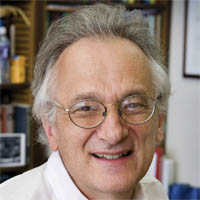JBC: Award winners pen essays
The American Society for Biochemistry and Molecular Biology’s annual awards honor scientific contributions across multiple dimensions: teaching, research in several subdisciplines, groundbreaking discoveries and whole lifetimes of work. To celebrate the multifaceted careers of the 2018 ASBMB award winners, the editors of the Journal of Biological Chemistry invited them to submit articles on topics of their choosing, from reflecting on their paths through science to taking the bird’s-eye view of research in their fields. Here we share excerpts for these articles. To explore these topics in more depth, go to “ASBMB award winners in the spotlight” on the Virtual Issues page.
What I got wrong about shelterin

By Titia de Lange
Bert and Natalie Vallee Award in Biomedical Science
The ASBMB award honors our work on shelterin, a protein complex that helps cells distinguish the chromosome ends from sites of DNA damage. Shelterin protects telomeres from all aspects of the DNA damage response, including ATM and ATR serine/threonine kinase signaling and several forms of double-strand break repair. Today, this six-subunit protein complex could easily be identified in one single proteomics step. But it took us more than 15 years to piece together the entire shelterin complex, one protein at a time. Although we did a lot of things right, here I tell the story of shelterin’s discovery with an emphasis on the things that I got wrong along the way.
Lessons from my undergraduate research students

By Paul A. Craig
ASBMB Award for Exemplary Contributions to Education
From very early on, my personal/professional life has been shaped by teachers in many different settings. Teaching and learning form a two-way street. In the process of teaching undergraduate students, particularly in the research lab, I have learned some profound lessons about the importance of listening to them, challenging them, giving them autonomy, and allowing them to enjoy success and to risk failure. I am now working with a team of faculty members to implement these lessons in a course-based undergraduate research experience in the biochemistry teaching laboratory. Our goal is to seek answers to the question “How do students become scientists?” and to implement those answers with our future students.
Mechanism of premature translation termination
on a sense codon

By Andrei Korostelev
Earl and Thressa Stadtman Young Scholar Award
Accurate translation termination by release factors is critical for the integrity of cellular proteomes. Premature termination on sense codons, for example, results in truncated proteins, whose accumulation could be detrimental to the cell. Nevertheless, some sense codons are prone to triggering premature termination, but the structural basis for this is unclear. To investigate premature termination, we determined a cryo-EM structure of the Escherichia coli 70S ribosome bound with RF1 in response to a UAU sense codon. The structure reveals that RF1 recognizes a UAU codon similarly to a UAG stop codon, suggesting that sense codons induce premature termination because they structurally mimic a stop codon.
My winding trail while fulfilling my love for science and family

By Kim Orth
ASBMB–Merck Award
My winding path toward a career in science was awkward, like an adolescent finding an identity. It did not follow a classic course; it had many interruptions, complications and challenges. It also involved a bit of luck and extremely supportive colleagues, mentors and family, including my husband, children and in-laws. I was inspired to tell my story here because I met a young woman interviewing in 2018 for graduate school who is growing up with the same complicated family expectations, social challenges, love for science and desire to be a scientist as I had four decades ago. Her future is uncertain, because her chosen academic path is not encouraged by those around her. We, as a society, must find ways to encourage, promote, enable, and give strength to those who want to follow their dreams, despite facing many challenges in their lives. Here are some things I learned on my career path that I hope might be helpful for others.
Visual cycle proteins: structure, function and roles
in human retinal disease

By Andrew Tsin
Ruth Kirschstein Diversity in Science Award
Genetic retinal disorders such as retinitis pigmentosa, Leber’s congenital amaurosis, and Stargardt’s disease are linked to structural changes in visual cycle proteins. Moreover, recent reports suggest that visual cycle proteins may also play a role in the development of diabetic retinopathy. Basic science has laid the groundwork for finding a cure for many of these blindness-causing afflictions, but much work remains. Some translational research projects have advanced to the clinical trial stage, while many others are still in progress, and more are at the ideas stage and remain yet to be tested. Progress in our understanding of the visual cycle will inform intervention strategies to preserve human vision and prevent blindness.
The ribosome: a hot spot for the identification
of new types of protein methyltransferases

By Steven G. Clarke
William C. Rose Award
There are presently few systems where the full physiological role of protein methylation is understood. The question then arises of how useful is it to discover new types of protein methylation reactions when we do not fully understand the systems already described. Do such discovery efforts represent mere cataloging of modification enzymes and their substrates? The fact that the proteins are methylated by the products of genes that have often been conserved throughout the evolutionary development of organisms suggests that a full understanding of the biology of an organism needs to include an appreciation of these modifications and their functions. As we learn more from each new protein methylation system described, the range of functional roles also increases, and we are provided new targets for therapeutic intervention into human diseases.
Enjoy reading ASBMB Today?
Become a member to receive the print edition four times a year and the digital edition monthly.
Learn moreGet the latest from ASBMB Today
Enter your email address, and we’ll send you a weekly email with recent articles, interviews and more.
Latest in Science
Science highlights or most popular articles

Building the blueprint to block HIV
Wesley Sundquist will present his work on the HIV capsid and revolutionary drug, Lenacapavir, at the ASBMB Annual Meeting, March 7–10, in Maryland.

Gut microbes hijack cancer pathway in high-fat diets
Researchers at the Feinstein Institutes for Medical Research found that a high-fat diet increases ammonia-producing bacteria in the gut microbiome of mice, which in turn disrupts TGF-β signaling and promotes colorectal cancer.

Mapping fentanyl’s cellular footprint
Using a new imaging method, researchers at State University of New York at Buffalo traced fentanyl’s effects inside brain immune cells, revealing how the drug alters lipid droplets, pointing to new paths for addiction diagnostics.

Designing life’s building blocks with AI
Tanja Kortemme, a professor at the University of California, San Francisco, will discuss her research using computational biology to engineer proteins at the 2026 ASBMB Annual Meeting.

Cholesterol as a novel biomarker for Fragile X syndrome
Researchers in Quebec identified lower levels of a brain cholesterol metabolite, 24-hydroxycholesterol, in patients with fragile X syndrome, a finding that could provide a simple blood-based biomarker for understanding and managing the condition.

How lipid metabolism shapes sperm development
Researchers at Hokkaido University identify the enzyme behind a key lipid in sperm development. The findings reveal how seminolipids shape sperm formation and may inform future diagnostics and treatments for male infertility.
